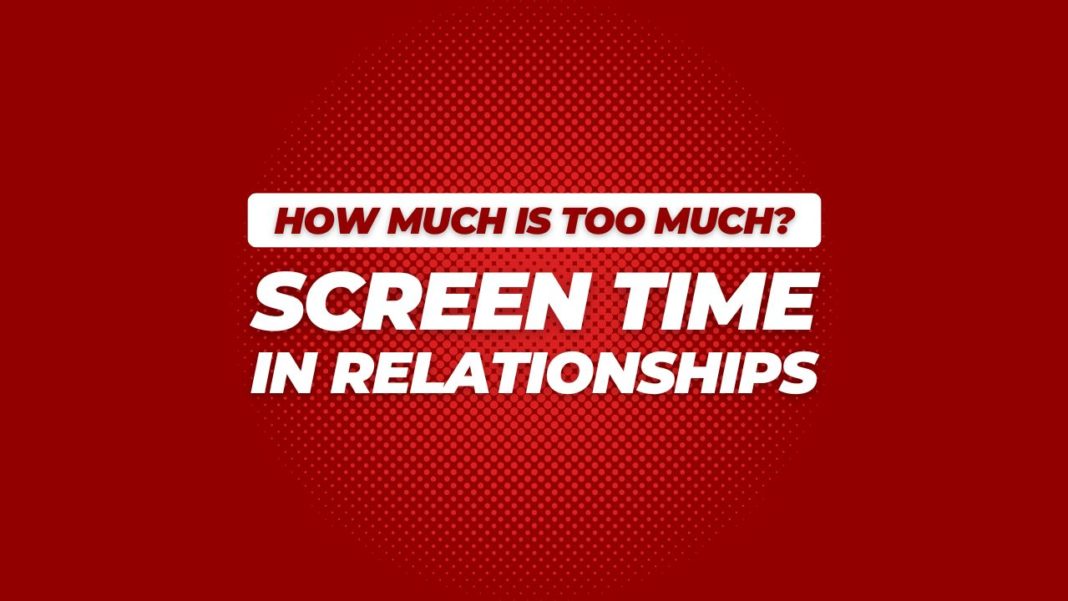Introduction to Screen Time in Relationships
In today’s digital age, ‘screen time’ has become an integral part of how new relationships blossom and grow. Within the context of budding romantic connections, screen time primarily encompasses texting, the use of social media platforms, video calls, and other forms of digital communication. Each mode offers unique ways for partners to connect, share moments, and learn about each other, regardless of physical distance.
primarily encompasses texting, the use of social media platforms, video calls, and other forms of digital communication. Each mode offers unique ways for partners to connect, share moments, and learn about each other, regardless of physical distance.
However, while digital tools can foster intimacy, their overuse might also lead to issues that can strain a new relationship. It’s crucial to strike a balance. Excessive screen time can replace valuable face-to-face interactions, potentially leading to misunderstandings and a sense of disconnect. On the other hand, not enough digital interaction might make a person feel neglected or out of the loop. Therefore, understanding the role of digital communication and finding a balanced approach is essential for the health and dynamics of new relationships. This balance ensures that the digital world supports rather than hinders the natural development of personal connections.
The Role of Communication Frequency
Determining the ideal frequency of digital communication in the early stages of dating is more an art than a science. It varies widely among individuals and relationships. Some couples might find constant texting reassuring and bonding, while others may prefer more space and less frequent check-ins to maintain a sense of independence and intrigue.
Benefits of Frequent Communication
Frequent digital communication can quickly strengthen the bond between new partners by creating a constant sense of presence and availability. It can accelerate the sharing of personal details and daily experiences, fostering a sense of intimacy and inclusion. According to relationship experts, this can be particularly beneficial for nurturing trust and openness in the early phase of a relationship. Psychologists suggest that for individuals who value affirmation and reassurance, frequent texts or messages can significantly boost relationship satisfaction.
Pitfalls of Frequent Communication
However, too much communication can also lead to saturation where one or both partners feel overwhelmed by the expectation to keep up constant contact. This might lead to stress and a feeling of being controlled or monitored, potentially stifling the natural development of the relationship. Overcommunication can blur personal boundaries and reduce the excitement of anticipation and personal space that are vital for long-term interest.
Benefits of Infrequent Communication
On the other hand, less frequent communication can enhance the quality of interactions. It allows for more significant experiences and thoughts to accumulate, which can make conversations more substantial and meaningful. This approach supports the development of other aspects of an individual’s life outside the relationship, promoting a healthier, well-rounded lifestyle. Psychologically, it can also heighten interest and anticipation for each communication, making each interaction more impactful.
Pitfalls of Infrequent Communication
Conversely, infrequent digital interactions can sometimes be interpreted as disinterest or neglect, particularly if one partner expects more frequent communication. It can lead to anxiety and insecurity, potentially causing tension and miscommunication.
Quality Over Quantity
In the digital realm of new relationships, the quality of interactions often proves more crucial than the sheer volume of messages exchanged. Meaningful communication can enhance emotional connectivity far more effectively than frequent, superficial exchanges.
Importance of Meaningful Interactions
Quality interactions are characterised by conversations that involve genuine curiosity, personal disclosures, and empathetic responses. These exchanges foster a deeper understanding and appreciation of each other’s personalities, values, and life aspirations. Research in psychological science suggests that relationships built on meaningful communication are likely to experience greater satisfaction and longevity. These interactions contribute to a richer, more intimate bond, creating a strong emotional foundation that can better withstand the challenges of relationship growth.
Tips for Engaging and Valuable Digital Interactions
Be Intentional with Your Communication: Choose times for digital communication when you can be fully present. This mindfulness allows for more thoughtful responses and shows your partner that they are a priority.
Diversify the Modes of Communication: While texting is quick and convenient, incorporating video calls, voice notes, or even shared online activities can add variety and depth to your interactions. These different modes can help convey emotions and nuances that text alone might miss.
Share Meaningful Content: Send articles, music, or videos that resonate with your personal tastes or relate to discussions you’ve had. This not only sparks further conversation but also shows that you are engaged in the relationship and attentive to shared interests.
Ask Open-Ended Questions: Encourage dialogue that requires more than a yes or no answer. Questions about feelings, opinions, and experiences invite longer, more meaningful exchanges and show a genuine interest in your partner’s life.
Practice Active Listening: Reflect on what your partner says and respond thoughtfully. Active engagement demonstrates that you value their thoughts and feelings, reinforcing their importance in your life.
Schedule ‘Digital Dates’: Set aside specific times for in-depth conversations, just as you would for a physical date. These sessions can help maintain the excitement and anticipation that come with scheduled, quality time together.
Setting Boundaries Early On
Establishing healthy boundaries around digital communication is crucial in new relationships, as it helps manage expectations and fosters mutual respect. Clear boundaries ensure that digital interactions enhance rather than hinder the natural development of the relationship.
The Importance of Setting Digital Boundaries
Boundaries in digital communication help prevent misunderstandings and protect each individual’s personal space and privacy. They allow both partners to feel comfortable with their interactions without feeling overwhelmed or intruded upon. Setting these boundaries early in the relationship can also prevent the formation of potentially harmful habits, such as over dependence on digital communication or the erosion of in-person intimacy.
Tips for Setting Healthy Digital Boundaries
Communicate Openly About Preferences
Early in the relationship, discuss each other’s preferences for communication frequency and mode. Be honest about what makes you feel comfortable and respected.
Agree on Response Times
Understand that immediate responses may not always be possible or necessary. Agree on acceptable response times and communicate openly if a delay is expected to manage expectations and reduce anxiety.
Establish ‘Digital-Free’ Times
Identify times or situations where digital devices should be put aside, such as during meals, late at night, or during special occasions. This helps ensure that both partners are fully present during shared times and respects each other’s need for undistracted attention.
Respect Privacy
Avoid the urge to monitor each other’s online activities. Trust is foundational, and respecting privacy underlines trust and personal independence.
Use Technology Positively
Rather than focusing solely on restrictions, consider how technology can enhance your relationship. For instance, sharing a calendar for date planning or sending reminders about events and anniversaries can strengthen your bond.
Regularly Review Boundaries
As the relationship evolves, so might your communication needs and preferences. Make it a practice to regularly discuss and adjust your digital boundaries as needed.
Benefits of Digital Boundaries
Having well-defined digital boundaries helps maintain interest and respect between partners. It ensures that time spent together is quality time and that interactions are meaningful rather than obligatory. By respecting each other’s digital boundaries, couples can build a stronger, more trusting relationship. These boundaries also prevent burnout from constant connectivity, keeping the relationship fresh and engaging. Each partner’s commitment to these boundaries demonstrates respect and care for the other’s well-being, further deepening their connection.
Recognising Red Flags
Excessive screen time can sometimes create barriers rather than bridges in a relationship, especially if it becomes intrusive or replaces meaningful personal interaction. Recognising the signs of such issues early can help couples address them before they escalate into more significant problems.
Signs of Negative Impact from Excessive Screen Time
Neglecting Face-to-Face Time
If one or both partners consistently prefer texting or using social media over spending time together in person, it may indicate that screen time is supplanting real-world interaction.
Anxiety Over Response Times
Excessive worry about how quickly one’s partner responds to texts or messages can be a sign of unhealthy attachment to digital communication. This anxiety may lead to tension and conflict.
Digital Monitoring Behaviours
Feeling the need to constantly check a partner’s online activity or text messages indicates a lack of trust and respect for privacy. This behavior can be damaging to the relationship’s foundation of trust.
Decreased Interest in Shared Activities
A noticeable decline in interest or involvement in activities that used to be enjoyable for the couple can suggest that digital interactions are overshadowing real-life connection.
Guidance on Addressing These Issues Constructively
Open Communication
Discuss concerns without accusations. Use “I” statements to express how certain behaviors make you feel, rather than blaming your partner. For example, say “I feel a bit neglected when we don’t spend as much time together as we used to,” instead of accusing your partner of ignoring you.
Set Clear Expectations
Revisit your digital communication habits and expectations. It might be helpful to establish certain times when both partners agree to be offline, especially during meals or special moments together.
Counselling and Workshops
If digital habits are deeply ingrained and difficult to change, consider seeking help from relationship counsellors who can offer professional advice and workshops on building healthier communication habits.
Develop Shared Activities
Engage in new or favourite activities together that don’t involve screens. This can strengthen your bond and ensure you both value the time spent in each other’s company.
Technology Breaks
Implement regular breaks from technology to focus on each other. Even small changes like turning off phones for an hour during a date night can make a significant difference.
Rebuild Trust
If trust issues arise from digital monitoring behaviours, work on rebuilding trust through consistent, transparent behavior and possibly professional help if needed.
Recognising and addressing these red flags promptly can help maintain the health and happiness of the relationship. Constructive dialogue and mutual agreement on digital habits are essential in nurturing a supportive and enduring partnership.
Balancing Screen Time with Personal Interaction
In an era where digital devices are ever-present, finding a balance between screen time and personal interaction is key to fostering a healthy and fulfilling relationship. Here are several practical ways couples can achieve this balance:
Strategies to Balance Digital and Personal Interaction
Prioritise Quality Time
Make it a point to spend quality time together without the presence of screens. Whether it’s a date night, a walk in the park, or cooking a meal together, ensure these moments are free from digital distractions.
Digital Detox Days
Designate days or parts of the day as digital detox times where both partners agree to put away their devices. This can help both individuals reconnect with each other without the interference of constant notifications and social media updates.
Tech-Free Zones
Establish certain areas in the home, such as the bedroom or dining area, as tech-free zones to encourage conversation and connection without the presence of digital devices.
Engage in Shared Hobbies
Take up a new hobby or activity that both partners can enjoy together. Activities that require cooperation and interaction, such as dancing, hiking, or DIY projects, can strengthen the relationship and reduce the urge to check devices.
Scheduled Digital Communication
For couples in long-distance relationships or those with busy schedules, setting specific times for digital communication can help manage expectations and enhance the quality of interactions.
Long-Term Benefits of Healthy Digital Communication Patterns
Establishing healthy digital communication patterns early in the relationship sets a strong foundation for ongoing interaction and intimacy. Here are some of the long-term benefits:
Enhanced Trust and Security
Consistent and balanced communication helps build trust and makes both partners feel secure in the relationship, knowing that they are prioritised over digital distractions.
Improved Communication Skills
By balancing screen time with personal interaction, couples develop better communication skills, learning to read each other’s emotions and verbal cues more effectively.
Deeper Emotional Connection
Quality time spent together increases emotional intimacy and understanding, helping to deepen the connection between partners.
Stress Reduction
Less reliance on digital communication can reduce stress associated with miscommunications and misunderstandings that often occur through text-based messages.
Increased Relationship Satisfaction
Couples who actively manage their screen time and prioritise personal interactions tend to report higher levels of relationship satisfaction and longevity.
Conclusion: Harmonising Digital Dances with Real-World Romance
In conclusion, effectively balancing screen time with personal interaction is crucial in cultivating a healthy relationship in today’s digital age. By setting clear boundaries, prioritising face-to-face engagements, and regularly detoxing from digital devices, couples can enhance their communication and deepen their connection. The commitment to fostering this balance early in the relationship sets a robust foundation for trust, reduces potential stress from digital miscommunications, and significantly improves overall relationship satisfaction. Embracing these practices not only nurtures individual well-being but also ensures that the relationship thrives in both digital and personal spaces, harmonising the modern rhythms of technology with the timeless dance of romance.






